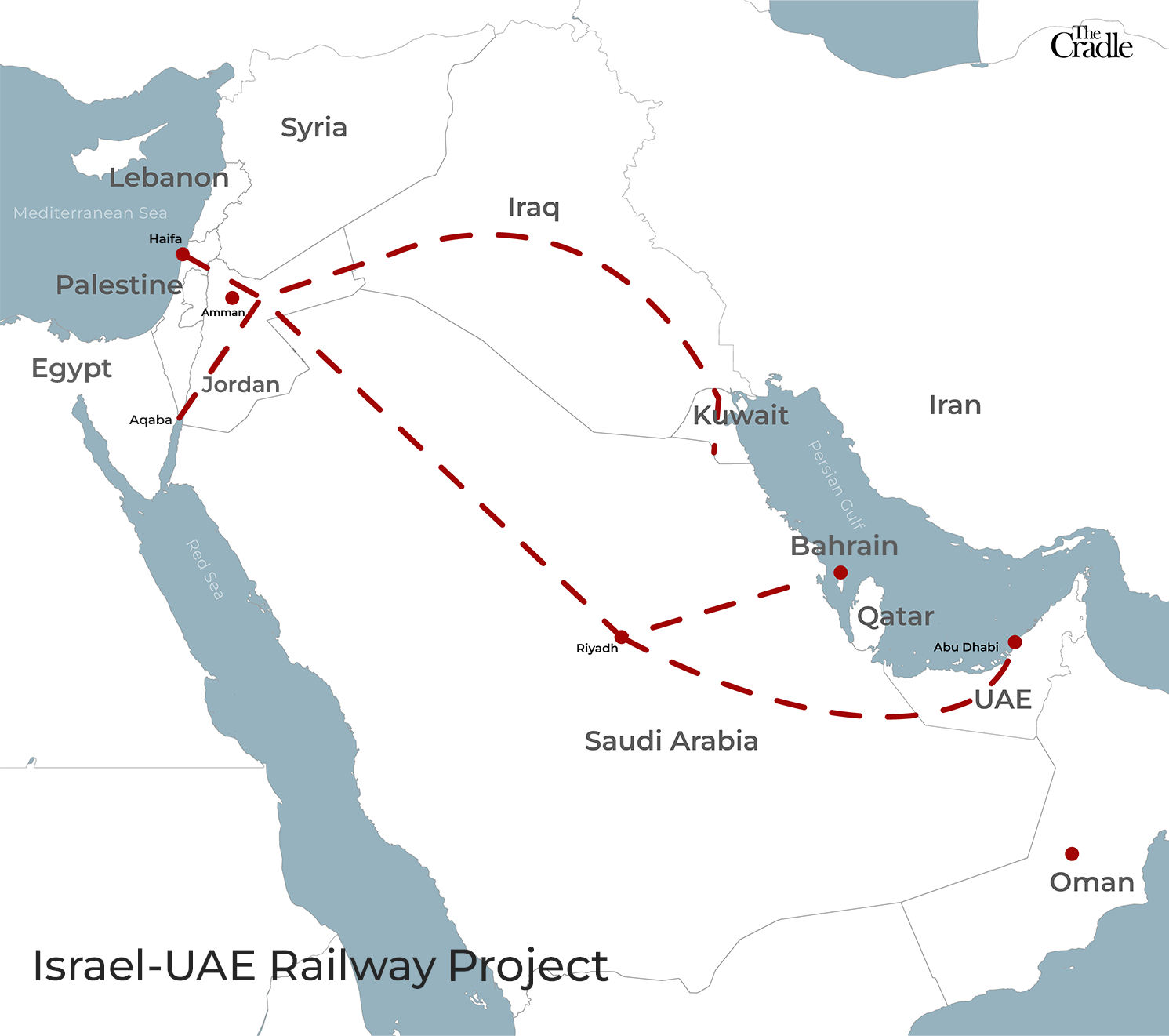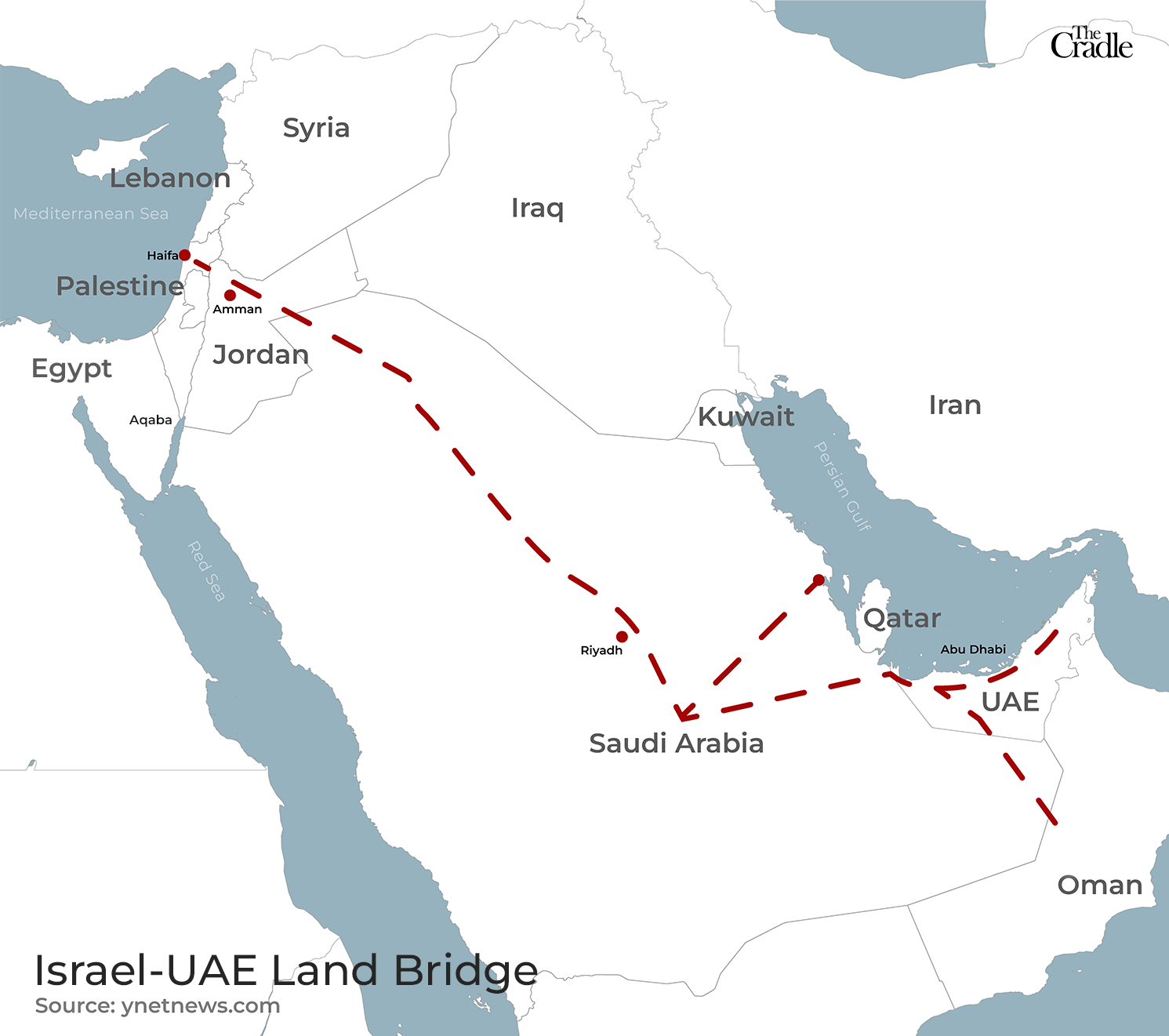
Mohamad Hasan Sweidan, The Cradle, August 17, 2023 —
Israel is pursuing land and railway connections as a means to pave the path for normalization and become Europe’s trading hub with West Asia. But logistical challenges and significant regional popular opposition may stop this project in its tracks.
Since 2017, under an initiative known as “Tracks for Regional Peace,” Israel has been trying to promote a railway project linking the port of Haifa with Persian Gulf states, including the UAE. This venture, which has already been set in motion, gathered greater significance following the normalization agreement between Abu Dhabi and Tel Aviv in 2020.
In July, it was reported that Israel and the US were working on a plan for a land connection project for trucks traveling between Israel and the UAE via Jordan and Saudi Arabia. The two projects together intend to connect the Mediterranean Sea and the Persian Gulf.
Reviving the Hejaz Railway
In 2017, then-Israeli Minister of Transportation Yisrael Katz, who is currently energy minister, presented his vision for the project. What’s striking is that this grand plan had already been a topic of discussion between Israel, select Arab countries, and even the administration of former US President Donald Trump, prior to its official endorsement by the government of Prime Minister Benjamin Netanyahu.
The proposed trajectory traces a path along the Marg Train line, an existing rail route stretching from Haifa to Beit She’an, nestled near the Jordanian border. The journey continues into Jordan through the Jordan River crossing, known as the Sheikh Hussein Bridge, and intersects the country’s internal railway network before converging at the strategic Red Sea port of Aqaba.

Map of Israel-UAE railway project (approximate)
From Jordan, the line continues into Saudi Arabia and then the UAE, and will likely extend to the Sultanate of Oman. This intricate web of connectivity not only binds the occupied Palestinian territories with the Persian Gulf’s ports, but paves the way for potential extensions into Iraq and Kuwait.
A map of the envisioned project makes evident that the Israeli initiative is modeled after the historic Hejaz Railway — a 1,464-kilometer railway line built by the Ottoman Empire to transport passengers, pilgrims, and goods from Palestine to Syria, and from there to Saudi Arabia via Jordan.
That line was inaugurated in 1908 by Sultan Abdul Hamid II personally. The following year, daily trips were established between Haifa and Damascus, and three weekly ones between Damascus and Medina. The latest Israeli proposal seeks to revive the old Hejaz line, but with the UAE replacing Syria, for obvious reasons. In fact, Israeli Minister of Intelligence and Transport Yisrael Katz has bluntly stated: “I want to revive the Hejaz Railway. This is not a dream at all.”
Land link to the Persian Gulf
In a strategic bid to expedite diplomatic engagement and foster closer ties with select Arab states, Israel’s land link project aims to enhance trade and connectivity within West Asia, through a proposal orchestrated by the Israeli Foreign Ministry and handed over to US envoy Amos Hochstein. However, although several Israeli political figures have confirmed that work on the project is underway between Washington and Tel Aviv, there is still no official endorsement from the parties involved.
Presently, the route taken by trucks traveling from the UAE to the port of Haifa is mired in bureaucratic complexities, necessitating multiple drivers, intricate paperwork, and lengthy waiting periods at border crossings. In contrast, the proposed project offers the possibility of one driver and one truck moving between Dubai and the port of Haifa without changing drivers and trucks at border crossings between countries.
The project will enable trucks to transport goods while significantly reducing both time and transportation costs. A study by the Israeli Foreign Ministry and the US government estimates that it will reduce the time of transporting goods between Israel and the UAE, saving up to 20 percent in shipping costs.
Notably, the requisite infrastructure to facilitate the movement of trucks between the port of Haifa and UAE ports is already in place. The primary impetus for success lies in overcoming administrative and political hurdles, rather than requiring a comprehensive normalization agreement between Israel and Saudi Arabia.
Despite the absence of a formal agreement, in 2020, Riyadh permitted Israeli airlines to traverse its airspace, enabling crucial mobility between Israel and the UAE, and Bahrain. It stands to reason that a similar approach could be extended to ground transportation – a tangible step toward enhancing trade flows and relations between the apartheid state and Saudi Arabia, bringing them closer to a potential formal normalization.

Map of Israel-UAE land bridge project (approximate)
Economic gains for Israel
The land link initiatives set forth by Israel, while ostensibly aimed at fostering regional cooperation, serve as multi-faceted strategies aligned with Tel Aviv’s economic, military, and political interests – many of which seek regional hegemony at the expense of neighbors. Any strategic Israeli moves will produce ramifications across West Asia’s economic, security, and geopolitical landscapes, raising Tel Aviv’s regional profile, but also potentially goading its opponents into action.
Primarily, the economic windfall arising from these projects bears paramount importance for Israel. Projections from the Israeli Ministry of Foreign Affairs suggest a staggering surge in trade volume from the proposed rail link initiative, potentially soaring to an astounding 400 percent.
This would represent a marked shift from the status quo, in which a multitude of trucks currently journey to the port of Haifa via Turkiye’s ferries, traversing through occupied Palestinian territories en route to various Arab countries through Jordan.
A rail and land link will allow the cost-effective and swift transport of goods to Arab markets, galvanizing Israeli producers to tap into new markets. For instance, the ease of exporting fresh vegetables, a vital commodity for the UAE, can expand trade in the agricultural sector considerably.
With rail or road trucks between the occupation state and the Persian Gulf, Israel will become increasingly important as a hub for transporting goods from Europe to Arab countries, and vice versa. According to minister Katz, 25 percent of Turkiye’s exports to the Gulf travel through Haifa’s port and pass through Jordan.
Beyond economic gains, there are also security benefits to be considered. The projects offer a distinct advantage in circumventing security vulnerabilities, deftly sidestepping the risks posed by Iran in the Strait of Hormuz and Yemen in the Bab al-Mandab Strait.
This maneuver culminates in a convergence of security interests between Israel and the Persian Gulf states, through bolstered security and military cooperation. By solidifying this alliance, Israel further advances its campaign to unite regional partners against its primary adversary, Iran.
Egypt’s concern
Geopolitically, the projects extend Israel’s influence, transforming it into an intrinsic and natural regional actor. This interconnectedness elevates its standing in the West Asian sphere by cementing vital links with Gulf states and positioning itself as a pivotal trade conduit between Europe and the region.
Such an influential role effectively nudges Israel into the center of diplomatic attention, which can advance the trajectory toward normalization with Arab states.
The Israeli-Gulf initiative will not, however, be viewed without concern in Egypt. The land link project threatens to divert business from the Suez Canal, a lifeline of global trade, and an anchor for Egypt’s now struggling economy. With approximately 12 percent of international trade, 10 percent of oil and gas shipments, and 22 percent of container trade traveling through the Suez Canal, the stakes are substantial.
The prospect of a land corridor diverting traffic from the Mediterranean to the Persian Gulf introduces a notable challenge to Cairo’s geoeconomic position in the region. A reduction in the canal’s significance poses an undeniable threat, as exemplified by Egypt’s record-setting revenues of $9.4 billion in the last fiscal year, which saw nearly 26,000 ships pass through the Suez.
A rocky road to normalization
In 2020, high-level discussions took place at the I2U2 forum, which brought together the US, Israel, the UAE, and India. It was here that Tel Aviv put forth its infrastructure project proposal aimed at connecting the Gulf and Arab states through a network of railways.
The project stipulates that India will also be linked to this project by connecting its ports to Gulf ports, in addition to Israel. The primary difference between these two projects is that Israel has publicly announced that it is a part of the land corridor project with the UAE.
Notably, the driving force behind both ventures remains unchanged; namely, a concerted effort to forge robust trade connections between Israel and various Arab states.
Yet any project involving Israel faces the formidable challenge posed by the enduring Arab-Israeli conflict, compounded by the steadfast support of West Asian populations for the Palestinian cause. Israel’s enduring position as an alien, colonial-settler state within West Asia, will continue to pose obstacles and direct opposition to its initiatives across the region.
